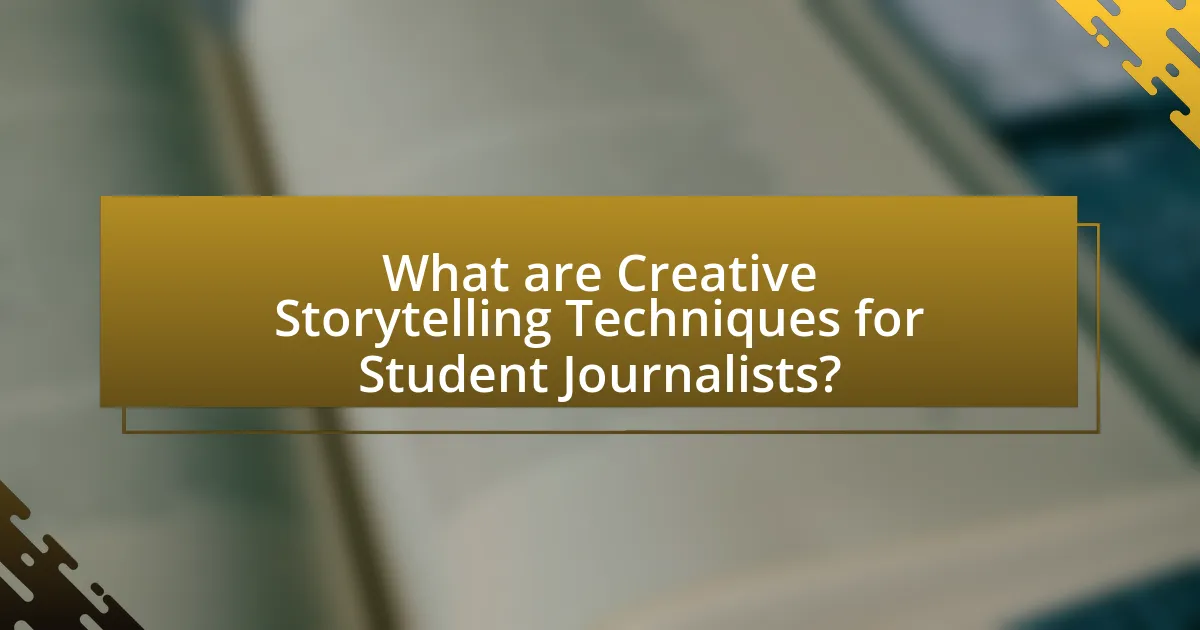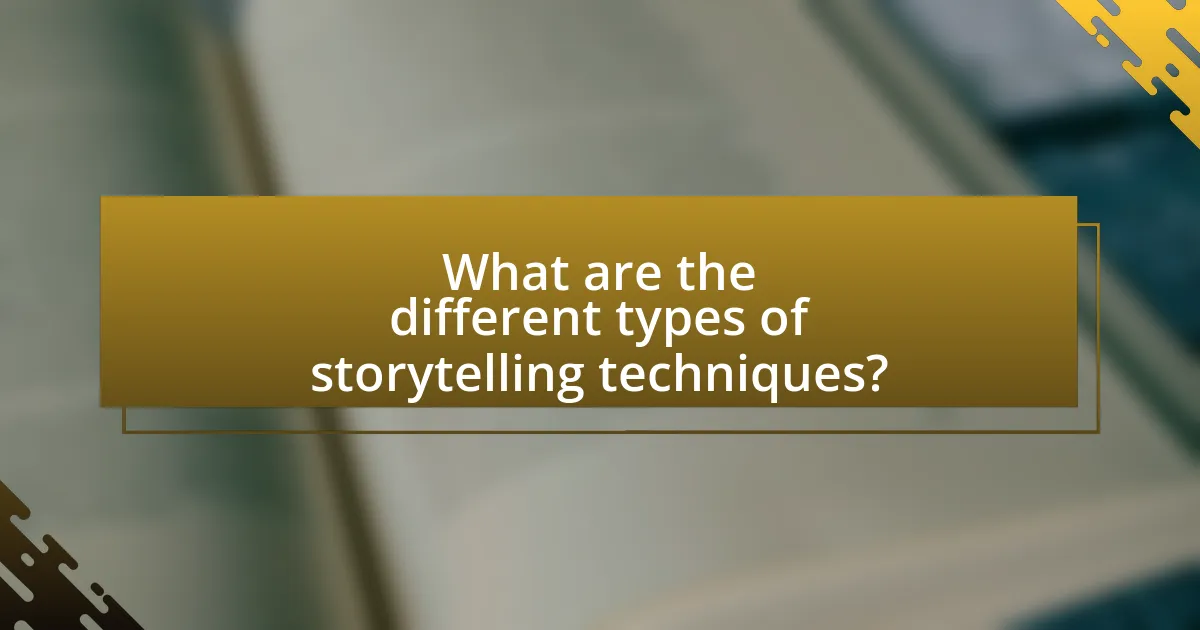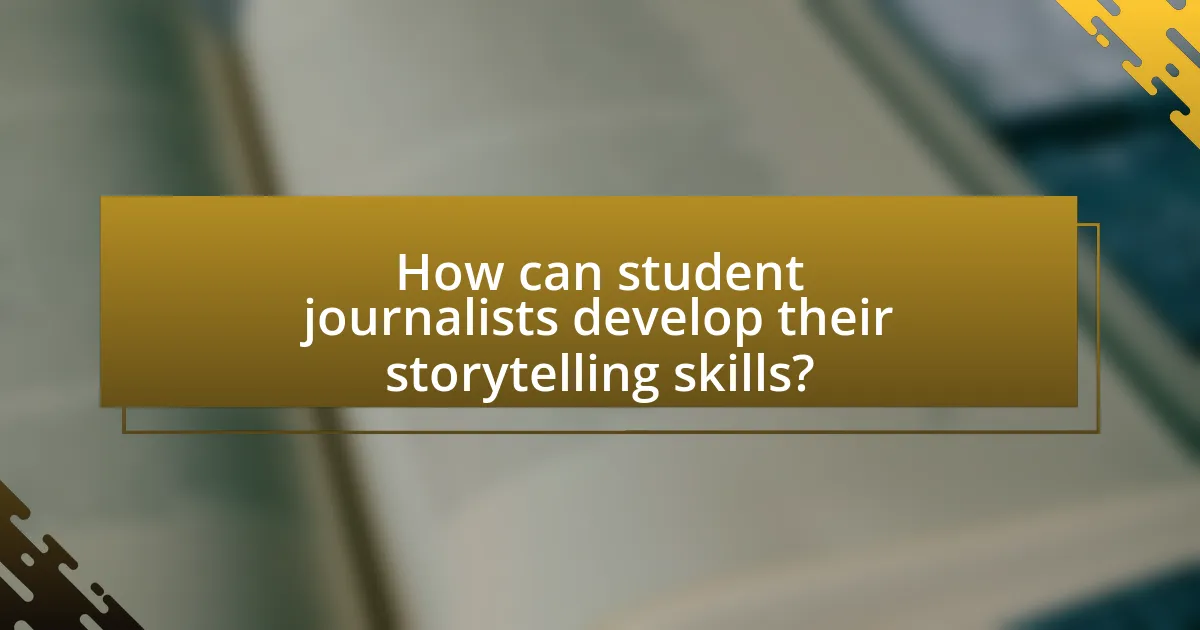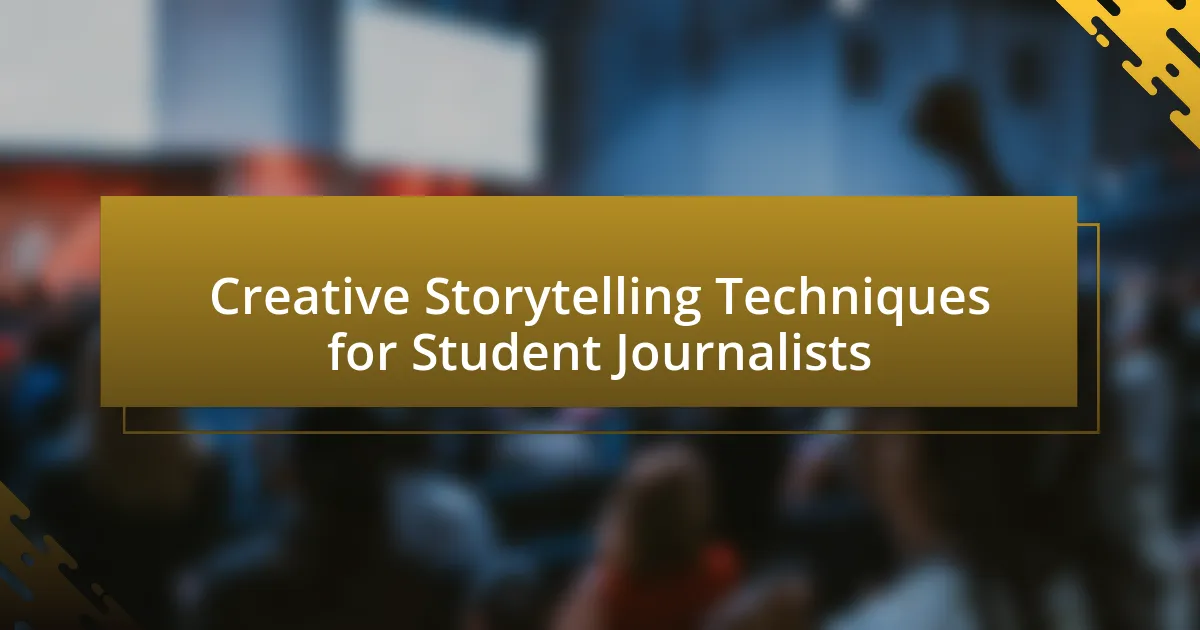Creative storytelling techniques for student journalists encompass various methods that enhance narrative engagement and audience connection. Key techniques include the use of narrative arcs, multimedia elements, and character-driven storytelling, which collectively make stories more relatable and memorable. The article outlines how these techniques improve journalistic storytelling by fostering emotional resonance and retention, while also discussing the importance of originality, structure, and factual accuracy. Additionally, it highlights practical exercises, resources, and common pitfalls to avoid, providing a comprehensive guide for student journalists aiming to refine their storytelling skills.

What are Creative Storytelling Techniques for Student Journalists?
Creative storytelling techniques for student journalists include using narrative arcs, incorporating multimedia elements, and employing character-driven storytelling. Narrative arcs help structure stories by providing a clear beginning, middle, and end, which engages readers and maintains their interest. Incorporating multimedia elements, such as audio, video, and interactive graphics, enhances storytelling by appealing to different senses and providing a richer context. Character-driven storytelling focuses on personal stories and experiences, making the content relatable and emotionally resonant for the audience. These techniques are supported by research indicating that stories with emotional connections are more memorable and impactful, as highlighted in studies by the Stanford Graduate School of Business, which found that narratives can significantly influence audience engagement and retention.
How do these techniques enhance journalistic storytelling?
Creative storytelling techniques enhance journalistic storytelling by making narratives more engaging and relatable to audiences. These techniques, such as the use of vivid imagery, character development, and emotional arcs, allow journalists to present information in a way that resonates on a personal level. For instance, incorporating personal anecdotes or real-life examples can transform a standard news report into a compelling story that captures the audience’s attention and fosters empathy. Research indicates that stories with emotional appeal are more likely to be remembered and shared, thereby increasing the impact and reach of journalistic work.
What are the key elements of effective storytelling in journalism?
The key elements of effective storytelling in journalism include a compelling narrative, strong characters, a clear structure, and factual accuracy. A compelling narrative engages the audience by presenting a relatable or intriguing story that captures attention. Strong characters, whether they are individuals or groups, provide a human element that readers can connect with emotionally. A clear structure, typically involving a beginning, middle, and end, helps to organize the information logically, making it easier for the audience to follow. Factual accuracy is essential, as it builds credibility and trust with the audience, ensuring that the story is not only engaging but also reliable. These elements work together to create impactful journalism that resonates with readers.
How do narrative structures influence reader engagement?
Narrative structures significantly influence reader engagement by shaping how a story is perceived and experienced. A well-defined narrative structure, such as the classic three-act structure, guides readers through a coherent progression of events, creating anticipation and emotional investment. Research indicates that stories with clear beginnings, middles, and ends enhance comprehension and retention, as evidenced by a study published in the journal “Cognitive Science,” which found that structured narratives lead to better recall of information. This structured approach allows readers to connect with characters and themes, fostering a deeper emotional response and sustained interest throughout the narrative.
Why is creativity important in journalism?
Creativity is important in journalism because it enhances storytelling, making information more engaging and accessible to audiences. Creative approaches allow journalists to present complex issues in relatable ways, fostering a deeper understanding among readers. For instance, innovative narrative techniques, such as using multimedia elements or unique angles, can capture attention and convey messages more effectively. Research indicates that stories told creatively are more likely to be remembered and shared, which is crucial in a media landscape saturated with information.
How does creativity differentiate student journalists from professionals?
Creativity differentiates student journalists from professionals primarily through the depth and originality of their storytelling. Student journalists often experiment with innovative formats and narratives, reflecting their fresh perspectives and willingness to take risks, while professionals typically rely on established conventions and industry standards honed through experience. This distinction is evident in the way student journalists may incorporate multimedia elements or unconventional angles to engage audiences, whereas professionals may prioritize clarity and adherence to journalistic ethics. The ability to think outside the box and adapt to new storytelling techniques is crucial for student journalists, as it allows them to stand out in a competitive field.
What role does originality play in storytelling?
Originality is crucial in storytelling as it differentiates narratives and engages audiences. Unique perspectives and innovative ideas capture attention, making stories memorable and impactful. For instance, studies show that original content is more likely to be shared and discussed, enhancing its reach and influence. This is evident in successful works like “The Catcher in the Rye” by J.D. Salinger, which introduced a distinct voice and perspective that resonated with readers, establishing a lasting legacy in literature.

What are the different types of storytelling techniques?
Different types of storytelling techniques include linear storytelling, non-linear storytelling, flashbacks, foreshadowing, and the use of multiple perspectives. Linear storytelling presents events in chronological order, while non-linear storytelling disrupts this sequence to create suspense or reveal information gradually. Flashbacks provide background by showing past events, and foreshadowing hints at future developments, enhancing anticipation. Multiple perspectives allow the narrative to be viewed through different characters’ viewpoints, enriching the story’s depth. These techniques are widely used in literature and journalism to engage audiences and convey complex narratives effectively.
How can visual storytelling be utilized by student journalists?
Visual storytelling can be utilized by student journalists to enhance narrative engagement and convey complex information effectively. By integrating images, videos, infographics, and other visual elements, student journalists can create compelling stories that resonate with their audience. Research indicates that articles with visuals receive 94% more views than those without, highlighting the importance of visual content in capturing attention and improving comprehension. Additionally, platforms like Instagram and TikTok demonstrate how visual storytelling can reach diverse audiences, making it a vital tool for student journalists aiming to communicate their messages effectively.
What tools are available for creating visual stories?
Tools available for creating visual stories include Canva, Adobe Spark, and Piktochart. Canva offers a user-friendly interface with templates for infographics and presentations, making it accessible for students. Adobe Spark provides options for creating web pages, videos, and graphics, allowing for diverse storytelling formats. Piktochart specializes in infographics and data visualization, enabling users to present information visually. These tools are widely used in educational settings, enhancing the storytelling capabilities of student journalists.
How does visual storytelling impact audience perception?
Visual storytelling significantly enhances audience perception by engaging viewers emotionally and cognitively. This technique utilizes images, videos, and graphics to convey narratives, making complex information more accessible and relatable. Research indicates that visuals can increase information retention by up to 65% compared to text alone, as demonstrated in studies by the Social Science Research Network. Furthermore, visual elements can evoke empathy and connection, influencing how audiences interpret and respond to the message being communicated. This impact is crucial for student journalists, as effective visual storytelling can shape public opinion and foster deeper understanding of the stories they present.
What are the benefits of using multimedia in storytelling?
Using multimedia in storytelling enhances engagement and comprehension. It combines text, images, audio, and video to create a richer narrative experience, catering to diverse learning styles. Research indicates that stories incorporating multimedia elements can increase retention rates by up to 60%, as they stimulate multiple senses and foster emotional connections. Additionally, multimedia storytelling can reach broader audiences through various platforms, making content more accessible and shareable. This versatility is crucial for student journalists aiming to effectively communicate their messages in a competitive media landscape.
How can audio elements enhance a story?
Audio elements can enhance a story by adding emotional depth and creating an immersive experience for the audience. For instance, background music can evoke specific feelings, while sound effects can provide context and realism, making the narrative more engaging. Research indicates that stories accompanied by audio elements are remembered better and elicit stronger emotional responses compared to text-only narratives. A study published in the Journal of Media Psychology found that participants who experienced stories with sound reported higher levels of engagement and emotional connection, demonstrating the significant impact of audio on storytelling effectiveness.
What are the best practices for integrating video into journalistic pieces?
The best practices for integrating video into journalistic pieces include ensuring that the video content enhances the storytelling, maintaining high production quality, and optimizing for various platforms. Integrating video should serve to clarify or deepen the narrative, providing visual context that complements the written word. High production quality, including clear audio and visuals, is essential as it reflects professionalism and engages the audience effectively. Additionally, videos should be optimized for different platforms, such as social media or websites, to maximize reach and accessibility, as studies show that video content can increase engagement by up to 1200% on social media platforms.

How can student journalists develop their storytelling skills?
Student journalists can develop their storytelling skills by actively practicing narrative techniques, engaging in workshops, and seeking feedback on their work. Engaging in regular writing exercises helps refine their ability to craft compelling narratives, while workshops provide structured learning opportunities from experienced journalists. Additionally, receiving constructive criticism from peers and mentors allows student journalists to identify strengths and areas for improvement, enhancing their storytelling capabilities. Research indicates that hands-on experience and mentorship significantly contribute to skill development in journalism, making these methods effective for aspiring storytellers.
What exercises can improve storytelling abilities?
Practicing storytelling can be enhanced through specific exercises such as writing prompts, character development exercises, and narrative structure analysis. Writing prompts encourage creativity and help students generate ideas, while character development exercises focus on creating detailed profiles for characters, enhancing depth and relatability. Analyzing narrative structures, such as the three-act structure or the hero’s journey, allows students to understand how stories are constructed, improving their ability to craft compelling narratives. These exercises are supported by educational research indicating that structured practice in these areas leads to improved storytelling skills among student journalists.
How can peer feedback enhance storytelling techniques?
Peer feedback enhances storytelling techniques by providing diverse perspectives that can identify strengths and weaknesses in a narrative. When student journalists receive input from their peers, they gain insights into how their stories resonate with different audiences, allowing them to refine their voice and structure. Research indicates that collaborative feedback processes can lead to improved writing quality, as highlighted in a study by Topping (1998), which found that peer assessment significantly boosts learning outcomes. This collaborative approach not only fosters critical thinking but also encourages a deeper understanding of narrative elements, ultimately leading to more compelling storytelling.
What role does reading play in developing storytelling skills?
Reading plays a crucial role in developing storytelling skills by exposing individuals to diverse narrative structures, styles, and vocabulary. Through reading various genres, storytellers learn how to construct plots, develop characters, and create engaging dialogues. Research indicates that frequent reading enhances comprehension and critical thinking, which are essential for effective storytelling. For instance, a study published in the Journal of Educational Psychology found that students who read regularly demonstrated improved narrative skills and creativity in their writing. This evidence supports the idea that reading not only enriches language but also provides practical examples of storytelling techniques that can be applied in creative writing.
What resources are available for learning storytelling techniques?
Resources available for learning storytelling techniques include books, online courses, workshops, and podcasts. Notable books such as “The Storytelling Animal” by Jonathan Gottschall and “Made to Stick” by Chip Heath and Dan Heath provide foundational insights into narrative structure and effective communication. Online platforms like Coursera and MasterClass offer courses specifically focused on storytelling, taught by industry professionals. Workshops conducted by organizations like The Moth and local writing centers provide hands-on experience and feedback. Additionally, podcasts such as “The Moth Podcast” and “StoryCorps” showcase storytelling in practice, offering examples of effective techniques. These resources collectively enhance understanding and application of storytelling techniques for aspiring student journalists.
Which books are recommended for aspiring student journalists?
“Recommended books for aspiring student journalists include ‘The Elements of Journalism’ by Bill Kovach and Tom Rosenstiel, which outlines the principles of journalism, and ‘On Writing Well’ by William Zinsser, focusing on clarity and style in writing. Additionally, ‘The Associated Press Stylebook’ serves as a crucial reference for journalistic standards and practices. These texts provide foundational knowledge and practical skills essential for effective storytelling in journalism.”
What online courses can help improve storytelling skills?
Online courses that can help improve storytelling skills include “The Art of Storytelling” offered by the University of Washington on Coursera, which focuses on narrative techniques and audience engagement. Another valuable course is “Storytelling for Business” by the University of Cambridge on edX, emphasizing the application of storytelling in professional contexts. Additionally, “Creative Writing: The Craft of Plot” on Coursera, provided by Wesleyan University, teaches essential plot development skills crucial for effective storytelling. These courses are designed to enhance storytelling abilities through structured learning and practical exercises.
What are some practical tips for effective storytelling?
Effective storytelling involves engaging your audience through clear structure, relatable characters, and vivid imagery. Start with a strong hook to capture attention, followed by a well-defined narrative arc that includes a beginning, middle, and end. Incorporate relatable characters to foster emotional connections, as studies show that audiences are more likely to engage with stories featuring characters they can identify with. Use descriptive language to create vivid imagery, which enhances the audience’s ability to visualize the story. Additionally, employing conflict and resolution keeps the audience invested, as narratives with tension are proven to maintain interest. Finally, practice active listening and feedback to refine your storytelling skills, as continuous improvement is essential for effective communication.
How can student journalists find their unique voice in storytelling?
Student journalists can find their unique voice in storytelling by actively engaging in self-reflection and experimenting with different writing styles. Self-reflection allows them to identify their personal experiences, values, and perspectives that shape their narratives. Experimenting with various formats, such as first-person accounts or multimedia storytelling, helps them discover what resonates most with their audience. Research indicates that diverse storytelling techniques enhance engagement; for instance, a study by the Pew Research Center found that stories incorporating personal anecdotes significantly increase reader connection and retention. By combining self-awareness with creative experimentation, student journalists can effectively cultivate a distinctive voice in their storytelling.
What common pitfalls should student journalists avoid in storytelling?
Student journalists should avoid several common pitfalls in storytelling, including lack of thorough research, which can lead to inaccuracies and misinformation. Inaccurate reporting undermines credibility and can damage reputations, as evidenced by numerous cases where journalists faced backlash for publishing unverified claims. Another pitfall is failing to engage the audience through compelling narratives; stories that lack emotional resonance often fail to capture attention. Additionally, student journalists should avoid bias in their reporting, as presenting a one-sided perspective can mislead readers and diminish the integrity of the story. Lastly, neglecting the importance of structure can result in disorganized narratives that confuse rather than inform the audience. These pitfalls can significantly impact the effectiveness and reliability of student journalism.

Leave a Reply